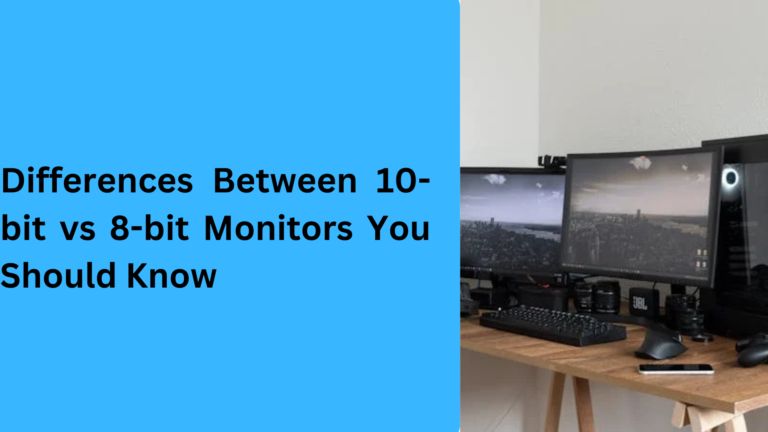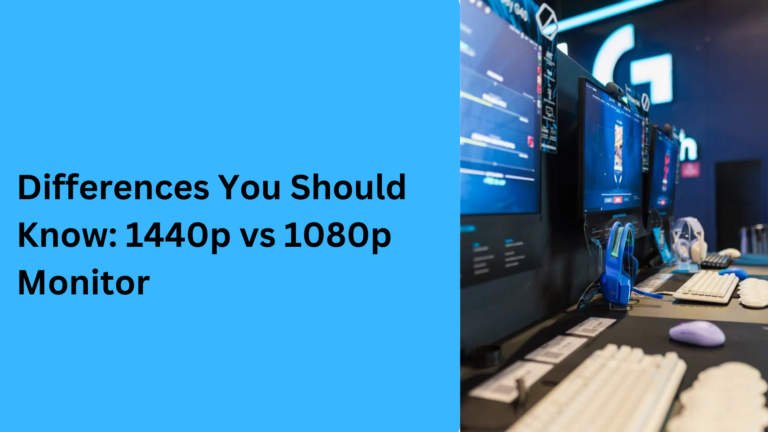10 Key Differences Between 32-inch vs 42-inch 4K Monitors You Should Know
When considering purchasing a 32-inch or a 42-inch 4K monitor, it’s important to understand how these sizes differ. Both have their advantages and disadvantages, depending on your usage, space, and preferences. Whether you are looking for a monitor for gaming, video editing, or general productivity, these differences can make a huge impact on your experience. Below, we explore the five most important differences between 32-inch and 42-inch 4K monitors, to help you choose the perfect screen size for your needs.
1. Screen Size: Understanding the Key Differences Between 32-inch vs 42-inch 4K Displays
The most obvious difference when comparing a 32-inch vs 42-inch 4K monitor is the actual size of the screen. A 32-inch monitor is generally considered ideal for desks with limited space, offering a compact yet spacious display for everyday tasks like office work, browsing the web, or casual gaming. On the other hand, a 42-inch 4K monitor offers a much larger workspace, ideal for immersive gaming experiences, media consumption, or even multi-tasking with multiple windows open at once.
If you’re working with limited space, a 32-inch 4K monitor might be a better fit. However, for those looking for a larger screen for entertainment or a more expansive work area, a 42-inch display will deliver that cinematic experience.
2. Viewing Distance: Which Size is More Comfortable for Extended Use?
Another important factor to consider is the optimal viewing distance. When using a 32-inch vs 42-inch 4K monitor, the ideal viewing distance changes. A 32-inch monitor is typically best viewed from about 2 to 3 feet away, making it a perfect option for small desks or office spaces. With a 42-inch 4K monitor, however, you might find yourself sitting further away (about 3 to 4 feet) to maintain comfortable viewing angles and prevent eye strain.
A 32-inch 4K monitor may be better for close-range viewing, especially for detailed tasks like reading text or working with design software. A 42-inch display, however, might be ideal for watching movies or playing games where you want a more immersive experience from a slightly further distance.
3. Resolution: Why 4K Matters More with Larger Screens
Both 32-inch and 42-inch monitors have the same 4K resolution (3840 x 2160 pixels), which means they offer exceptional clarity and crisp details for all kinds of media. However, the pixel density differs between the two sizes. On a 32-inch 4K monitor, the pixel density is much higher, meaning individual pixels are smaller and the image appears sharper at close range.
With a 42-inch 4K monitor, the pixels are larger, and while the display is still sharp, you may notice a slight reduction in clarity if you’re sitting too close to the screen. The key takeaway here is that, while both provide an excellent 4K viewing experience, a 32-inch screen will offer a sharper image when viewed up close, while the 42-inch model offers a more expansive, immersive display, especially at a greater viewing distance.
4. Desk Space & Mounting: Which Size Fits Your Setup Better?
Size is also a critical factor in terms of desk space. A 32-inch monitor will require less physical space on your desk, making it ideal for small or cramped workspaces. It’s easier to position a 32-inch 4K monitor comfortably on most desks, without worrying too much about clutter or space limitations. However, with a 42-inch 4K monitor, you will need a more spacious desk and possibly a sturdier monitor stand to hold it properly.
In terms of wall mounting, both sizes are generally compatible with VESA mounts, but a 42-inch 4K monitor will require a stronger mount to support the weight and size. If you have limited desk space and want to keep your setup minimal, a 32-inch monitor might be a better choice.
5. Price Difference: Is the Larger Monitor Worth the Extra Investment?
When comparing a 32-inch vs 42-inch 4K monitor, price is an important consideration. Typically, 42-inch 4K monitors are more expensive than their 32-inch counterparts. While both offer similar resolutions and performance, the larger size often comes with additional features like enhanced sound systems, better color accuracy, and more advanced display technologies.
However, if you are on a budget and don’t need the extra screen real estate, a 32-inch 4K monitor can offer excellent value for money. On the other hand, if you are willing to invest in a larger screen for entertainment, gaming, or professional use, the 42-inch 4K monitor can provide an enhanced visual experience that justifies the higher price.
6. Gaming Performance: Is the Extra Size Worth It for Gamers?
For gamers, screen size plays a significant role in the gaming experience. When choosing between a 32-inch vs 42-inch 4K monitor, the larger screen size of the 42-inch display provides a more immersive experience. It fills your peripheral vision more effectively, making games feel more engaging, especially in open-world or first-person shooter titles. A 42-inch 4K monitor allows you to see more of the environment, which can enhance gameplay, especially in racing, simulation, and action games.
That said, a 32-inch monitor also offers an excellent gaming experience, especially for competitive gamers who prefer sharper details and faster response times. A smaller screen also allows you to focus more easily on specific parts of the game, which can be advantageous in competitive eSports or strategy-based games. If you’re into casual gaming, a 32-inch screen might be all you need, while a 42-inch monitor can take gaming to the next level for those seeking a cinematic experience.
7. Energy Consumption: Which Size Uses More Power?
While both 32-inch and 42-inch 4K monitors use similar display technology, the larger 42-inch screen will generally consume more power due to its increased size and brighter display. For long periods of use, this can add up, especially if you are using the monitor for work, gaming, or entertainment for several hours daily.
A 32-inch 4K monitor is more energy-efficient because it has a smaller display and less power demand. If energy efficiency is a concern for you and you’re looking to minimize electricity costs, a 32-inch monitor might be a better choice. However, if you’re already using multiple devices or have a large home office setup, the energy difference might not be significant enough to outweigh the benefits of a larger screen.
8. Color Accuracy: Which Monitor Provides Better Visuals for Creatives?
If you’re in a profession that requires precise color reproduction, such as photo editing, graphic design, or video production, color accuracy is a crucial factor. Both 32-inch and 42-inch 4K monitors offer great resolution, but the difference comes in terms of how well the screen handles color accuracy, contrast, and brightness.
While many 42-inch 4K monitors come with advanced display technologies like OLED or higher-end LED panels for better contrast, the smaller 32-inch 4K monitors tend to offer more precise color accuracy due to the higher pixel density. The more compact screen size often results in better visual consistency, particularly if you work with design software or need precise color for professional tasks. On the other hand, a 42-inch monitor may provide a more vibrant experience but might not always match the same level of color precision found in smaller, more specialized monitors.
9. Portability: Which Size is Easier to Move Around?
If you need a monitor that’s easy to move between different workspaces, the portability factor is another important consideration. A 32-inch 4K monitor is significantly lighter and easier to move around, whether you’re transporting it to a different room, taking it to a work event, or moving it from home to an office. The size and weight of a 32-inch monitor make it far more convenient for individuals who need to relocate their workspace frequently.
On the other hand, a 42-inch 4K monitor is much bulkier and heavier, making it less portable. If you plan on having a stationary setup and do not need to move your monitor often, the larger screen may not pose an issue. However, for users who need flexibility, a 32-inch model is easier to handle.
10. Multi-Tasking: Which Size is Better for Productivity?
For productivity and multi-tasking, a 42-inch 4K monitor has a clear advantage. The larger screen size gives you ample space to run multiple windows simultaneously, which is perfect for people who work with several applications or need to keep an eye on different information streams at once. Whether you’re working with spreadsheets, monitoring several web pages, or editing videos, a 42-inch screen allows for an expansive workflow.
In contrast, a 32-inch 4K monitor is ideal for those who focus on a smaller number of tasks at once. While you still get plenty of screen real estate, the screen size is better suited for tasks that require less multi-window management. For most professionals who need to multitask, a 42-inch monitor would be more efficient and help streamline their workflow, while a 32-inch monitor may suffice for users who prefer a more focused work environment.
1. What is the best viewing distance for a 32-inch vs 42-inch 4K monitor?
The optimal viewing distance for a 32-inch 4K monitor is typically around 2 to 3 feet, which allows for sharp, detailed visuals without strain. For a 42-inch 4K monitor, the ideal viewing distance is usually 3 to 4 feet. The larger screen size requires you to sit farther away to maintain comfortable viewing angles and prevent eye fatigue. If you’re using your monitor for tasks like photo editing or gaming, adjusting your distance accordingly can enhance your experience.
2. How does the price compare between a 32-inch 4K monitor and a 42-inch 4K monitor?
A 32-inch 4K monitor is generally more affordable compared to a 42-inch 4K monitor. The larger screen size of a 42-inch 4K display often comes with additional features, like enhanced color accuracy and improved display technologies, which can increase the price. If you’re on a budget but still want a high-quality 4K display, a 32-inch monitor offers excellent value. However, if you’re seeking a more immersive experience and are willing to invest, a 42-inch 4K monitor provides a larger workspace and better viewing comfort.
3. Is a 42-inch 4K monitor good for gaming?
Yes, a 42-inch 4K monitor is excellent for gaming, especially if you want an immersive experience. The larger screen provides a more expansive view, which is ideal for genres like racing, simulation, or open-world games. However, if you’re a competitive gamer who values speed and precision, a 32-inch 4K gaming monitor might be a better choice due to its higher pixel density and quicker response times. Ultimately, it depends on whether you prefer a larger, more cinematic experience or a sharper, more responsive display for competitive gameplay.
4. Can a 32-inch 4K monitor be used for professional photo editing?
A 32-inch 4K monitor is an excellent option for professional photo editing, especially if you need a high level of detail and sharpness. The higher pixel density on a 32-inch 4K display ensures that images appear clear and crisp, which is crucial for photo editing. However, a 42-inch 4K monitor can also be used if you prefer a larger workspace for multitasking, but the pixel density may be lower. For those who prioritize color accuracy and detail, a 32-inch 4K monitor might provide more precise results.
5. What are the benefits of choosing a 42-inch 4K monitor for multi-tasking?
A 42-inch 4K monitor is ideal for multi-tasking because it offers more screen real estate to open multiple windows and applications simultaneously. With the larger screen size, you can have documents, spreadsheets, video editing tools, and web pages open side by side without feeling cramped. If you’re a professional who needs to juggle several tasks at once, the extra space provided by a 42-inch 4K display makes multitasking much more efficient. However, a 32-inch monitor can also be effective for less intensive multi-tasking needs if you have limited desk space.


